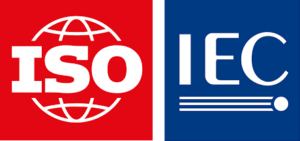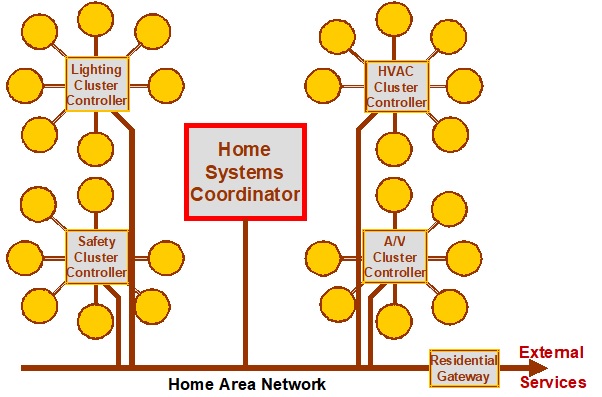This is the fourth article in a year-long series that premiered in November 2021 on international standards for energy management. These standards support the transformation of the power grid from centralized generation to distributed energy resources including local solar, wind, and stored energy in homes and buildings.
 These are voluntary industrial standards developed to promote world trade by a committee I chair for ISO1 and IEC2. They are part of a family of standards for interconnected consumer electronics (home automation) called the “Home Electronic System” (HES) 3. I welcome your comments and participation in developing these standards; please visit kenwacks.com for contact data.
These are voluntary industrial standards developed to promote world trade by a committee I chair for ISO1 and IEC2. They are part of a family of standards for interconnected consumer electronics (home automation) called the “Home Electronic System” (HES) 3. I welcome your comments and participation in developing these standards; please visit kenwacks.com for contact data.
Energy Management Agent (EMA) Data & Control
I introduced the international standard Energy Management Agent (EMA) in the previous article in this series. The EMA is a type of consumer electronics product that helps users manage energy whether generated locally, obtained from storage, or purchased from neighbors, a microgrid, an aggregator, or a public utility. This article explores the data needed by the EMA for automated operation while fulfilling the user’s goals. It also examines how appliances could respond to control signals from the EMA and a practical method for accommodating existing appliances.
Electrical Energy Measuring System (EEMS)
Integral to the HES energy management system is the ability to measure and modify system performance including premises use, generation, and storage of electricity. Traditionally, electricity consumption is measured only at one point, namely, the electric meter. Electric utilities supply and manage electric meters at the demarcation point (e.g., at the service entrance to the premises where the electricity service line from the distribution grid is terminated). Electric meters with remote reading access are often known as “smart meters.” The primary function of smart meters is customer billing using government-approved metrology methods and technologies. The international standard ISO/IEC 15045-5-24 introduces local power measurements at the point-of-use by selected appliances to facilitate the decisions made by the EMA for allocating power based on consumer desires and goals. Locations where local power measurements are recommended include:
- Solar and wind power generation (at the input to an inverter)
- Stationary batteries (e.g., Tesla Powerwall)
- Mobile batteries in electric vehicles (EVs)
- Appliances and other loads
- Utility or aggregator power via the grid
- Transactive energy using a private power feed
These energy measurements are primarily intended to enable effective energy management by providing the EMA with electricity flow data and analysis of loads (application systems or specific appliances), local generation, and storage. Measurement techniques have advanced in accuracy with reduced costs to enable such on-premises measurements. A feature of IoT (Internet of Things) is the proliferation of low-cost sensors. The power measuring devices proposed for supporting the EMA functions are examples of such IoT-sensor devices. These distributed measurement devices on premises constitute an Electrical Energy Measuring System (EEMS).
EMMA: EMA + EEMS
The combination of an EMA with an EEMS is called EMMA, Energy Management and Measurement Application, in the HES standards. EMMA supports measurement of electrical parameters and power flows in order to determine the optimal allocation of power according to the consumer’s goals.
Future electricity infrastructure deployments may shift generation resources from a public utility to locally-based renewable sources that fluctuate with the weather and time-of-day. Measurements of power consumption by major appliance loads are becoming increasingly important inputs so the EMA can allocate power to loads as local supplies fluctuate. These measurement features combined with the computation features5 of the EMA enable EMMA to provide accurate automated energy management so users can balance appliance usage when desired against goals such as staying within a budget or limiting their environmental impact. If power supplies are constrained by events (such as weather) or too expensive according to the user’s budgetary limit, the EMA can shift power to critical loads.
Energy Allocation to appliances and EV chargers
The prime benefit of the EMA is the tailoring of energy allocation based on user preferences for appliance operation and power sources (such has “green energy”), and user constraints such as a monthly budget for energy. Once the EMA has determined where to allocate power, it must convey this message to the affected appliances and EV chargers. Most appliances were not designed to respond to a power allocation message. The only option is to interpose a switch module (often called a smart plug) between the appliance power cord and an outlet.
Smart plugs allow remote curtailment of power to a specific appliance via an app or voice control. Controlling an appliance by cutting power is a crude method of control. Furthermore, it is likely to be ineffective for appliances controlled by a microprocessor. Many such processors reset the appliance when power is restored, or may lose configuration data unless non-volatile or battery-backup memory is designed into the product.
Responsive appliances
Energy management would be simplified if all appliances were designed with internal controllers programmed for intelligent responses to energy management messages (called responsive appliances). Many appliances include controllers that communicate data with sensors, actuators, and user interfaces to provide various functions. These components are usually embedded in or dedicated to an appliance. Appliance controllers could be designed to include expanded responsibilities for communicating with cluster controllers (specified in ISO/IEC TR 14543-46 and the ISO/IEC 10192-47 series). These cluster controllers provide management and coordination for applications such as energy management, entertainment, lighting, health, safety, and comfort.
Figure 1 illustrates the structure of an integrated home system using cluster controllers to manage applications. The Home Systems Coordinator shown in the figure might offer a common user interface on a wall panel or a smart phone app to initiate applications and to coordinate operations across applications. For example, the lighting cluster controller could be programmed to adjust media room lights when the A/V cluster controller prepares to show a video.

Figure 1 – Home Automation Systems Organized by Cluster Controllers
Ideally the EMA, serving as the cluster controller for energy management, would communicate with appliances that understand energy management commands. If appliances were designed to operate in modes with reduced energy consumption, the EMA could request a percentage decrease in energy consumption to achieve the user’s goals, given the available electricity supply and costs. The ability to request an operating mode with reduced power consumption offers “shades-of-gray” between operating and curtailing appliances, so power consumption is reduced while appliances continues to run, but with some modes limited (such as temperature limits for AC and water heating). Smart appliances that consume significant energy might be designed to allow a choice of levels for energy consumption with the appliance features possibly limited at lower levels through a process I call appliance modulation.
As explained in ISO/IEC TR 14543-4 and the ISO/IEC 10192-4 series, HES applications are managed by cluster controllers. In this environment, the EMA sets operating modes for appliances and clusters by communicating target goals to the appropriate cluster controller or smart appliance. For example, HVAC energy reduction may require adjustments to temperature and relative humidity settings for each room evaporator and for the compressor, especially if it has variable speed control. These parameters are very specific to the HVAC design. Therefore, an HVAC system intended for energy management would interact with an EMA that specifies a target reduction and lets the HVAC controllers decide how to achieve that goal, rather than programming the EMA to adjust the thermostat.
Priority load center
In reality few appliances and HVAC systems are designed with built-in energy conservation modes that can be requested by the EMA. To accommodate these appliance limitations, the EMA needs to be adapted to the local premises environment, which may include a mix of appliances and application clusters with varying degrees of responsiveness to energy commands, EV charging stations, and local energy equipment (renewables and storage).
Appliances not designed with internal energy management features could be connected to circuits that are wired to a load center8 designed for a level of priority services. In a typical residential house or apartment, the appliances are powered from one load center containing all the circuit breakers on one electrical panel. ISO/IEC 15045-5-2 specifies multiple load centers where at least one is assigned for critical loads. For example, appliances important for human welfare, such as a refrigerator or medical monitor, would be plugged into a high-priority load center that connects to mains power plus local renewable power sources and storage for enhanced resiliency.
Adapting appliances for energy management
The HES family includes a standard interface for appliances that are switchable on/off or amenable to modulation of energy consumption (such as a thermostat adjustment). This is called the Modular Communications Interface (MCI) and is described in the next article.
1. ISO is the International Organization for Standardization, founded in 1947, www.iso.org.
2. IEC is the International Electrotechnical Commission, founded in 1906, www.iec.ch. Both ISO and IEC are headquartered in Geneva, Switzerland.
3. The Home Electronic System (HES) is the name of the international standards committee officially designated as ISO/IEC JTC 1/SC 25/WG 1:
JTC 1 = Joint Technical Committee 1, entitled Information Technology
SC 25 = Subcommittee 25, entitled Interconnection of Information Technology Equipment
WG 1 = Working Group 1, entitled Home Electronic System
4. ISO/IEC 15045-5-2, Information Technology – Home Electronic System (HES) gateway – Part 5-2: HES gateway energy services [In progress]
5. The computation features of the EMA including the use of artificial intelligence (AI) will be presented later in this series of articles.
6. ISO/IEC TR 14543-4, Information Technology – Home Electronic System (HES) architecture – Part 4: Home and building automation in a mixed-use building.
7. ISO/IEC 10192-4-1, Information Technology – Home Electronic System (HES) interfaces – Part 4-1: Common user interface to support interworking among home cluster systems – Architecture.
ISO/IEC 10192-4-2, Information Technology – Home Electronic System (HES) interfaces – Part 4-2: Common user interface to support interworking among home cluster systems – Interfaces, services and objects [In progress].
ISO/IEC 10192-4-3, Information Technology – Home Electronic System (HES) interfaces – Part 4-2: Common user interface to support interworking among home cluster systems – Messaging [In progress].
8. An electrical load center contains a panel of circuit breakers that provide protection against fires and shocks.
© Copyright 2021 Kenneth P. Wacks
Dr. Kenneth Wacks has been a pioneer in establishing the home systems industry. He delivers clear and practical advice to manufacturers and utilities worldwide on business opportunities, network alternatives, and product developments in IoT and AI for home and building systems. The United States Department of Energy appointed him to the GridWise® Architecture Council to guide the electric industry toward smart grids. For further information, please contact Ken at +1 781 662-6211; [email protected]; www.kenwacks.com.


